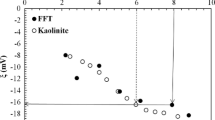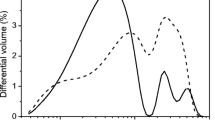Abstract
Consistency curves and characteristics of Newtonian, pseudoplastic, Bingham body, thixo-tropic and dilatant types of flow are reviewed. The theoretical effects of particle shape on effective hydrodynamic volume and shear resistance for ideal suspensions are considered.
The rheological properties of hydrogen and sodium mono base-exchanged kaolinite clays were determined, using a rotational viscometer, on slips containing up to 50 g solids per 100 g slurry. Changes in rheological properties were also evaluated as a hydrogen slip containing 20 g solids per 100 g slurry was converted into the sodium form.
The discussion includes the effect of differences in charges and charge distribution on the sodium and hydrogen particles and the resulting effects on particle orientation and flocculation. Correction factors for dissociation and particle interference have allowed the use of Einstein’s equation for the viscosity of a suspension up to concentrations of about 40 percent solids for the hydrogen kaolinite system, and about 50 percent solids for the sodium kaolinite system.
Similar content being viewed by others
Bibliography
Einstein, A., 1906, Eine neue Bestimmung der Moleküldimensionen: Ann. Physik, v. 19, p. 289–306.
Einstein, A., 1911, Berichtigung zu meiner Arbeit; “Eine neue Bestimmung der Moleküldimensionen”: Ann. Physik, v. 34, p. 591–592.
Green, H., 1949, Industrial rheology and rheological structures: John Wiley & Sons, Inc., New York, N. Y., 95 p.
Jirgensons, B., and Straumanis, M. E., 1954, A short textbook of colloid chemistry: John Wiley & Sons, Inc., New York, 420 p.
Johnson, A. L., and Norton, F. H., 1941, Fundamental study of clay. II. Mechanism of de-flocculation in the clay-water system: J. Amer. Ceram. Soc., v. 24, p. 189–203.
Moore, F., and Davies, L. J., 1956, The consistency of ceramic slips: Trans. Br. Ceram. Soc, v. 5, p. 313.
Peterlin, A., 1939, Determination of the size and axial ratio of ellipsoid-forming rigid particles by the innerfriction of diluted suspensions: Kolloid-z., v. 86, p. 230–241.
Peterlin, A., and Stewart, A. H., 1939, Determination of the size and shape, as well as the electrical, optical and magnetic anisotropy of submicroscopic particles with the aid of artificial double refraction and inner viscosity: Z. Physik, v. 112, p. 129–147.
Schofield, R. K., and Sampson, H. R., 1953, The deflocculation of kaolinite suspensions and the accompanying change-over from positive to negative chloride adsorption: Clay Minerals Bull., v. 2, p. 45–51.
Scott Blair, G. W., 1949, A survey of general and applied rheology: Second Edition, Pitman and Sons, London, 191 p.
Simha, R., 1940, The influence of Brownian movement on the viscosity of solutions: J. Phys. Chem., v. 44, p. 25–34.
Author information
Authors and Affiliations
Additional information
This study was sponsored as a Grant-in-Aid by the Institute of Geophysics, University of California, Los Angeles, California.
Rights and permissions
About this article
Cite this article
Langston, R.B., Pask, J.A. Analysis of Consistencies of Kaolin-Water Systems Below the Plastic Range. Clays Clay Miner. 5, 4–22 (1956). https://doi.org/10.1346/CCMN.1956.0050103
Published:
Issue Date:
DOI: https://doi.org/10.1346/CCMN.1956.0050103




